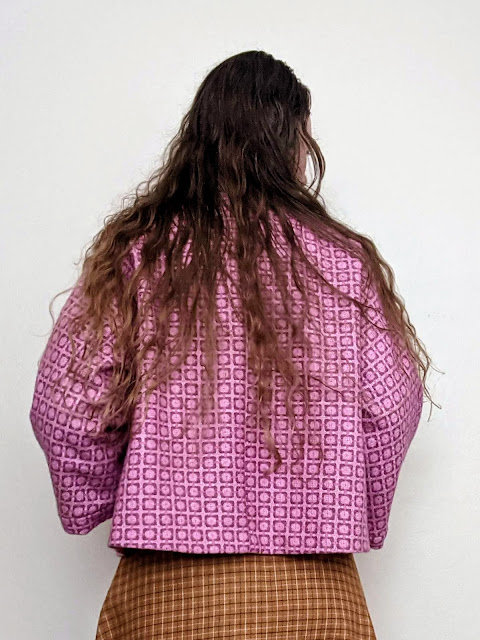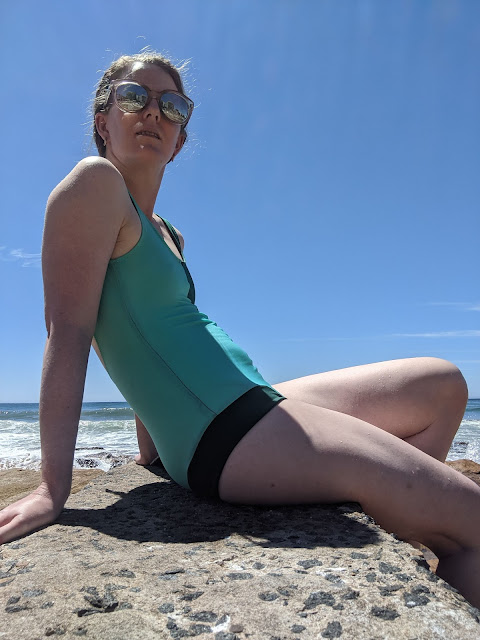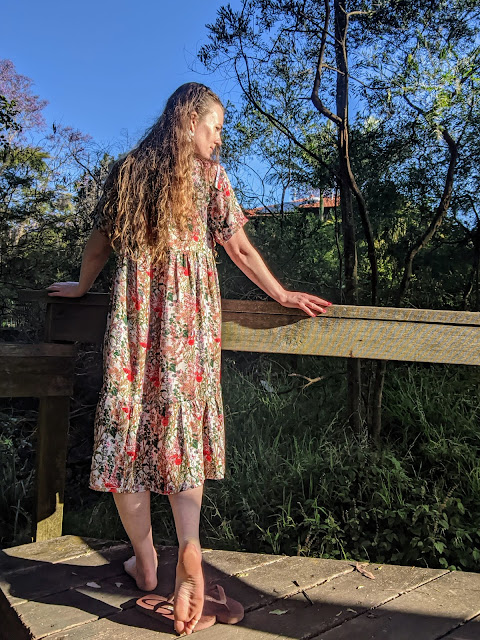Although I do own a lot of original and reproduction vintage patterns and sew with them regularly, I do always try and pull them out especially in September for Sew Vintage September. Especially with Covid lockdown again it is nice to be able to see everyone's makes on Instagram and feel connected to others joining in the vintage sewing for the month.
This absolutely beautiful fabric is one I picked up at a Sydney Spoolettes fabric swap a few years ago. The fabric design is called Australian Wildflowers and is covered in botanical drawings of different wildflowers, complete with common and scientific names as well as the states and territories they grow in. There are flannel flowers, spider flowers, swamp and Sydney golden wattle, Cooktown, lemon and blue lady orchids, kangaroo paw, brown boronia, Sturt's desert pea and waratahs among others. The colours are wonderfully vibrant, and although a few arent' quite accurate to the flowers they depict they are all equally lovely drawings.
Being an original 1950s pattern the shape of the upper bodice is very much designed to be worn with 1950s undergarments. The top edge of the upper bodice sat flat and correctly, but there was a lot of empty space between the top and the seam with the lower bodice. To remove some of the fullness I made the lower curve shallower and cut the sides of the piece straight rather than angled out to the lower edge. This kept the line of the top edge the same but reduced the height and width of the pattern piece so it was better sized.
The skirt is very wide and full. There are three 1.5m wide panels for a total width of 4.5m, while the bodice is only 66cm. This meant reducing down approximately 7cm of skirt for every 1cm of bodice. I gathered the skirt by hand in three sections, one for each skirt panel. It took approximately an hour to do the gathering and pin it in place, and then 15 minutes to carefully machine stitch it together. I had considered basting it together but ended up deciding the pins would be better at keeping the skirt from being pulled out of alignment while sewing. Because of the weight of the skirt I wanted to make sure the connection to the bodice was very sturdy, so I did a second line of stitching to make the connection more secure.
The bodice of the dress is lined, using a lightweight white lining. I sewed the straps in at the same time as attaching the bodice lining. To make sure I was still able to adjust the length each strap is two pieces: on attached in the front and one attached in the back. The zipper was installed before the lining was attached, and the lining was then machine stitched along the seam allowances joining the bodice pieces to keep the bodice and shell aligned, and hand stitched to the inside of the zipper tape and just inside the skirt seam. As with hand gathering the skirt this was a time consuming process but the finished product looks so much better for the effort.
The final step was to sew up the straps I had left open. As I mentioned there is minimal ease, so the dress sits close to the right spot when strapless. The original pattern actually has a strapless option where the bodice is boned, but I wanted this to be a bit more wearable so I included the straps. I pinned the two sides together at the shoulder before machine sewing at the top then trimming the excess and hand stitching closed. I probably pulled the straps up a couple of millimetres higher than needed, but it is to minor of an issue to be worth unstitching to adjust.
Despite how big the dress is it only used 2.85m of fabric. The skirt is three panels 1.5m wide by 75cm long, with 30cm for the bodice and straps and another 30cm to line the bodice. The pattern actually suggests the skirt also be lined, but given the weight of this fabric I decided that was unnecessary. I haven't posted every make here on my blog - I may do a roundup post of the ones later - but this brings me to 15.15 metres or 16.5 yards of fabric from my stash used as part of the Whole 30 Fabric Challenge. Just over halfway through, a bit under 15 metres now to go.
I love how this dress turned out. The waist seam is snug so I can't slouch in the dress but the fit is close to perfect. It's feminine and fun and the weight of the fabric makes it very wearable. Although for now it can only be worn at home, this dress is brightening my lockdown days.




















































